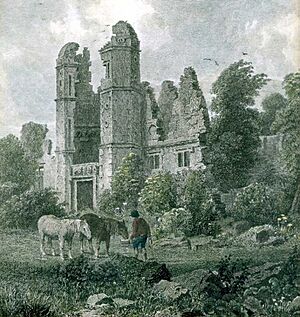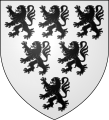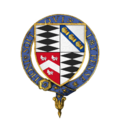Savage family facts for kids
Quick facts for kids House of Savage |
|
|---|---|
| Noble family | |
 Coat of arms of Savage: Argent, six lions rampant, sable |
|
| Country | Kingdom of England, Kingdom of Great Britain, United Kingdom |
| Place of origin | Normandy |
| Founded | 11th century |
| Founder | Thomas Le Sauvage |
| Titles |
|
| Motto | A te pro te ('From thee, for thee') |
| Estate(s) | Rocksavage Clifton Hall Halton Castle Frodsham Castle Beeston Castle Melford Hall Stainsby |
The Savage family is an old and important English noble family. They were founded by Thomas Le Sauvage (Savage). He came to England with William the Conqueror's army in 1066. After the conquest, he settled in Derbyshire. His name is on a list of Normans who survived the Battle of Hastings. Later, a part of the family moved to Cheshire in the 14th century. This is where they became very famous and powerful. Many family members became important leaders, like the Archbishop of York. The Cheshire branch built their main home, Rocksavage. This house was one of the most amazing Elizabethan homes in the county. There were also other parts of the family in different areas like Dorset, Gloucestershire, and Kent. One branch even went to Ireland. Many family members are buried in special tombs at St Michael's Church, Macclesfield.

Contents
The Savage Family: A Journey Through History
From Normandy to England
The Savage family began with Thomas Le Sauvage (Savage). He arrived in England with William the Conqueror's army in 1066. After the conquest, he received land in Derbyshire and made his home in Scarcliffe. The Savages became important members of the landed gentry. This means they owned a lot of land and were well-respected.
In the 14th century, a part of the family moved to Cheshire. This happened when Sir John Savage (1343–1386) married Margaret d'Anyers. She was the heir to lands around what became Rocksavage. This area became the most important place for the family.
Knights and Commanders
One of the first famous Savages in Cheshire was Sir John Savage (died 1450). He fought for Henry V of England in his wars in France. The King made him a knight after the Battle of Agincourt. He became very influential in the County Palatine, especially in Macclesfield. The Savage family chapel was later built in St Michael's Church there. This part of the family also built their main home, Rocksavage. It was a short distance from their earlier home, Clifton Hall.
The Savages often married into other important noble families. These included the Stanleys and the Morleys. Eventually, they gained their own noble titles. First, they became Viscounts Savage. Later, they became Earls Rivers.
Many Johns in the Family
For almost 200 years, the main heir in the Savage family was always named John. This sometimes made it confusing! There could be as many as four John Savages at one time.
One Sir John Savage was made a knight by Henry V. This was for his bravery at the Battle of Agincourt. Another Sir John Savage (1444–1492) was a key leader in Henry VII's army. He helped win the Battle of Bosworth Field. He led the left side of the army to victory that day. It is said he even defeated the Duke of Norfolk in a one-on-one fight. He was already a Knight of the Bath. After Henry became King, he was made a Knight of the Garter. This is the highest award for a knight in England.
Sir John also fought in other battles. These included the Battle of Barnet and the Battle of Tewkesbury in 1471. He also took part in the invasion of Scotland in 1482. After his victory at Bosworth, King Henry VII sent Sir John to arrest some rebels. Sir John led 60 armed men to get them. He died during the Siege of Boulogne when he refused to surrender.
What Happened to the Titles?
The family's main noble titles ended in 1737. This happened when the 5th Earl Rivers died. He was a Catholic priest and had no children. He had inherited the title from his cousin, Richard Savage, 4th Earl Rivers. Richard was a General in the British Army. He also had no legal male heir.
The family's main home, Rocksavage, stayed in the family until the late 1700s. Then, the last female heir married into the Cholmondeley family. The estate then passed to them. The Cholmondeley family already had a large home. So, Rocksavage was not needed and quickly fell apart. Today, only parts of the house's garden and orchard walls remain.
Famous Savages Through Time
Many members of the Savage family became important figures in history. Here are some of them:
- Sir Arnold Savage (died 1375) - A knight who held several important jobs. He was a military leader in Kent and Mayor of Bordeaux in France.
- Sir Arnold Savage (1358–1410) - Son of the first Sir Arnold. He was a knight who served as Speaker of the House of Commons. He also helped stop the Peasants' Revolt in 1381.
- Sir John Savage (c.1370–1450) - A knight who fought bravely at the Battle of Agincourt. King Henry V made him a knight for his service.
- Sir John Savage (1444–1492) - A famous knight and military leader. He led a key part of King Henry VII's army to victory at the Battle of Bosworth Field. He was made a Knight of the Garter.
- Archbishop of York Thomas Savage (1449–1507) - A bishop and diplomat. He was the younger brother of Sir John Savage. He served as a chaplain to King Henry VII. He became Bishop of Rochester, then Bishop of London, and finally Archbishop of York in 1501. He helped arrange the marriage between Prince Arthur and Catherine of Aragon. He also built the Savage Chapel at St Michael's Church, Macclesfield.
- John Savage (died 1586) - He was involved in a plot to kill Elizabeth I of England. He was meant to be the one to assassinate the Queen. He was executed for his part in the plot.
- Thomas Savage, 1st Viscount Savage (c. 1586–1635) - A courtier (someone who attended the King) for King Charles I. He helped the King with trade and increasing his income.
- Elizabeth Savage, Countess Rivers and Viscountess Savage - An English noblewoman. She was a supporter of the King during the English Civil War. She was the wife of Thomas Savage, 1st Viscount Savage.
- John Savage, 2nd Earl Rivers (1603–1654) - A Member of Parliament for Cheshire. He supported King Charles I during the English Civil War. He raised a regiment of soldiers to fight for the King. His home, Rocksavage, was damaged because of his support for the King.
- Thomas Savage, 3rd Earl Rivers (c. 1628–1694) - A Major General in the English army. He was falsely accused of being part of a plot against the King, but no charges were brought.
- Richard Savage, 4th Earl Rivers (c. 1654–1712) - A General in the British army. He held important positions like Constable of the Tower of London. He was one of the first nobles to support William of Orange when he came to England. William later became King William.
- Sir John Boscawen Savage (1760–1843) - A Major General in the Royal Marines. He was a high-ranking leader in the Royal Marines.
- Walter Savage Landor (1775–1864) - A famous English writer, poet, and activist.
- Alfred, Lord Tennyson (1809–1892) - A very popular British poet. He was the official poet for Queen Victoria for many years. He was related to John Savage, 2nd Earl Rivers.
Arms of the Savage Family
-
Arms of Sir John Savage as a Knight of the Garter





